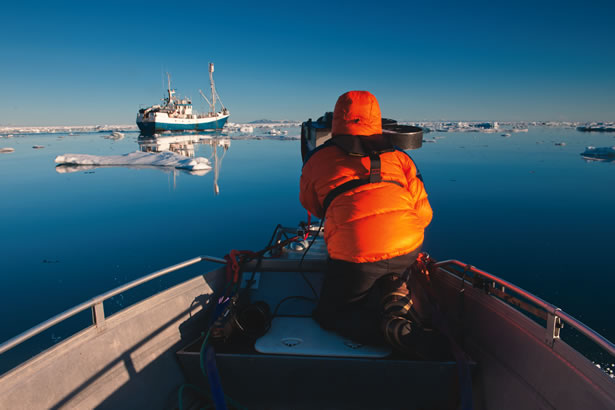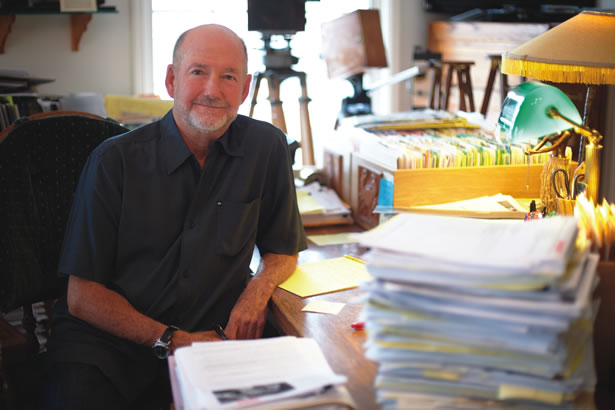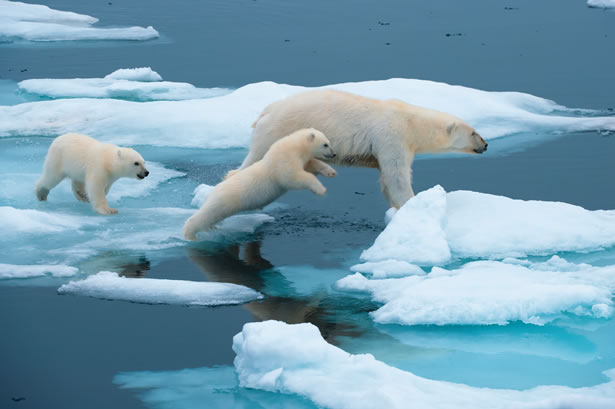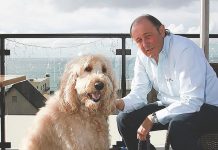Greg MacGillivray
Laguna Beach-based IMAX filmmaker Greg MacGillivray turns his lens, and $10 million of his own money, toward protecting ocean life with the new One World One Ocean Foundation. By Ted Reckas
Greg MacGillivray was asleep below deck on a 103-foot icebreaker somewhere off Svalbard, a remote archipelago well north of the Arctic Circle. The ship creaked as he lay there on a summer night, his crew on watch above as the sun shone brightly on the expansive ice field. A new mother polar bear nursed her cubs on a nearby ice floe, unthreatened by the crew’s presence—it was 3:43 in the morning.
With 36 IMAX films under his belt, including two Oscar nominations and countless expeditions all over the world, Greg was used to brutal shooting schedules. Still, when you sneak off to nap while working 20-hour days on location, you don’t get up unless it’s important. A crewmember shouted down the narrow stairwell, “Greg, you probably want to see this.”
A short distance from the bear family, a large, lone male worked through the cracked and crooked ice floes, sniffing the air as he swam, zeroing in on the mother and suckling cubs. The mother was sleeping (which she never did for more than 15 minutes), after a four-mile swim to escape another attack a few hours earlier. That time they had silently slipped into the water with a significant lead on the approaching male, but this time she detected him later.
“From the angle we had up on the boat, we could see the male moving in from behind but the female couldn’t see or smell him. There’s a shot where you can see the male in the background and the female is up on the ice with no urgency. Finally the bear got really close, extremely close, and he finally popped his head up and she saw him. She started panicking,” says Rob Walker, the camera assistant who was on watch when it happened.
She sent the cubs running downwind, giving the male no easy clues in the baffling landscape. Unlike most polar bears that lead their cubs, she had trained hers to run ahead, putting herself between them and the aggressor. There was no margin for error. He was only 30 feet behind her, running full speed on the ice, and twice her size.
“I was filming thinking I couldn’t believe I was here watching this. We thought we were going to see something horrible,” says producer, cinematographer and Greg’s son, Shaun MacGillivray.
The mother wheeled on her haunches and growled. The male paused. She took off and he pursued her with fervor. When he chopped another 10 feet off her lead, she spun and confronted him with a guttural roar—her babies were at stake; this would not end easily for him. Her resolve shocked the large male and he gave up. A short distance away, the cubs dog-paddled away through freezing water, their mother now not far behind. As they continued to put distance between themselves and the male, MacGillivray’s crew monitored their progress.
The mother signaled to the cubs and they broke off at an angle. She circled an ice floe and dove. The cubs bobbed in the water, two sets of blinking eyes taking in the tortured expanse of sea ice. Mom emerged with a seal in her jaws, dragged it onto the floe and the family promptly reduced it to a bloodstain on the ice. Afterward, they found a place in the contours of the ice floe, out of view—the cubs settled in to nurse, and the trio slept.
 “We talked to a bunch of experts and it’s never happened before where you can track a polar bear family for 24 hours a day, five days in a row. She could easily ditch us. But she knew she didn’t have to—we weren’t a threat,” Rob says.
“We talked to a bunch of experts and it’s never happened before where you can track a polar bear family for 24 hours a day, five days in a row. She could easily ditch us. But she knew she didn’t have to—we weren’t a threat,” Rob says.
“To the Arctic,” the first production in the MacGillivray’s One World One Ocean campaign, had just scored a central story impossible to script, with wild animals for main characters as cute and as compelling as they come. Filming two polar bear chases and two seal kills was unprecedented. But their windfall had an ominous source: the combined effects of global warming shrinking the ice field from its normal width of 50 miles down to 10, and the wind blowing the pieces of cracked ice into a compacted area had put an inordinate amount of free-roaming polar bears on top of one another. MacGillivray, who was there mainly to film Arctic seabirds and walrus, expected to see 30 bears at most. He and his crew saw 132.
“Being a polar bear mother is perhaps the hardest job in the world, and with climate change and the ice melting faster, that job is getting harder for her each year,” Greg says.
Greg has been watching the shift in sea life for decades, which inspired him, together with his son Shaun and others, to launch the nonprofit One World One Ocean Foundation. The charity’s goals include educating and inspiring millions of people worldwide—through films, new media and grassroots education—to come together, fight to make 10 percent of the world’s oceans marine reserves, and to change the way we consume sea life.
Surf Movie Magic
Greg is in love with the ocean. Decades before he won a lifetime achievement award at the International Wildlife Film Festival, he was a 14-year-old determined to make a professional grade film.
“It took me all through high school and into college to get it to be as good as I wanted it. There’s probably $1 million of sweat equity in the film, at 50 cents per hour,” Greg explains.
He took a year off of school at UC Santa Barbara where he was studying physics in 1965 to focus on film full time (they have no film department). While numerous surf movies, from “Big Wednesday” to “Riding Giants,” have succeeded largely by satiating the big wave thirst of armchair watermen, Greg’s film, “A Cool Wave of Color,” showcased small wave surfing in California only.
It was a hit. Why?
“It was completely different,” he says. “It was kind of like a beatnik surfing film: jazz music, unconventional humor, lots of art, lots of titling and fun stuff. It was esoteric. It didn’t exploit surfing but made it look artful. California surfing was the epitome of graceful, artistic surfing. Small wave surfing in glassy waves was the prettiest thing on the planet. That was conveyed through the film. Anyone who felt the same way I felt loved the film.”
The One World One Ocean Foundation is a more sophisticated manifestation of the same clear sentiment: Greg wants you to be in love with the ocean too.
Backyard Barometer
For 40 years, Greg has patrolled the stretch of beach in front of his house at the bottom of Cleo Street, and in a way it is his barometer for the state of the ocean.
“I come home from work and if the surf is good I go surfing. If not I go out with a snorkel and fins, and do a regular route,” he explains. “Over the past 40 years I’ve noticed a distinct change in the sea creatures, particularly the schooling fish. When I first did it, you would see all kinds of fish: corbina, two to three-pound fish that were a foot long or bigger. All that is gone. It’s rare I see a single fish that is even 8-inches long today. There used to be schools of hundreds of these fish. You would swim right through them in the sea grass.”
Laguna has been a focal point of the marine reserve debate in California for more than two years as the Marine Life Protection Act has labored toward conclusion. Most of Laguna is now slated for protection, but marine reserves account for less than a single percent of the ocean worldwide, and anyone who has seen “Whale Wars” knows the difficulty of trying to police literally the largest thing on the planet.
“Ninety percent of the big fish in our oceans are gone,” Greg says. “Scientists estimate that 70 percent of our planet’s coral reefs will be destroyed by mid-century. Ocean acidification and warming temperatures will cause yet unknown damage.”
One World One Ocean plans to revisit locations Greg and his crew pinpointed with GPS while filming other movies around the world a decade or more ago to document changes.
When explaining why he and wife Barbara have foregone salaries for the next 10 years and put $10 million of their own money into the campaign, Greg pares his words to brutal simplicity, “We are destroying what gives us life.”
Greg’s goals of increasing marine reserves to 10 percent of the world’s oceans and changing the way people consume sea life are both massively ambitious. Powerful movies about important issues have been done before, with unclear impact on the real world. However, One World One Ocean has a multi-faceted approach that goes beyond great movies.
Active Campaigns, Deep-rooted Ambivalence
Despite the release of Al Gore’s “An Inconvenient Truth,” Gallup polls over the last decade show Americans’ concern with global warming was largely unchanged after 2005 when the film hit theaters. Although 4 million people have seen the global warming slide show that Gore based his book and film on, according to the website, public perception of global warming as a serious problem has actually declined in the last few years. “The Cove,” another Oscar-winning documentary, which focused on the slaughter of whales and dolphins, inspired 1.4 million people to sign a petition of support, according to the film’s site, and has more than a half a million Facebook fans, but the effects on public opinion and behavior are little-known, and the killing of whales and dolphins has not stopped.
So how will One World One Ocean produce more tangible change? Shaun, who graduated from USC film school and has become an accomplished filmmaker in his own right, explains.
“‘The Cove’ was a very good film, but the problem I felt was that not that many people actually got to see it,” Shaun says. “Going into theatrical documentaries without any major promotional marketing is very difficult. Secondly, because it was so hard hitting, I think it turned a lot of people off. You saw too much blood of the dolphins. It may be an amazing film once you watch it, but you’ve got to get them in the theater. We are going to have major, major marketing throughout the campaign, creating what would typically be $50-$100 million in marketing dollars through the different partnerships we have.”
Shaun is managing director of the One World One Ocean Foundation: He forms partnerships, heads up fundraising and oversees strategy. In addition to a series of IMAX and regular format movies in 2D and 3D, of which Shaun is creative producer, there will be an eight-part TV series, numerous shorter TV spots, online videos, social media and allied marketing campaigns—all of it co-branded with major partners. Although he could not yet name names for the record as contracts are still being signed, one of the partners is a globally recognized brand sold in 200 countries.
This is not the first time Greg has parlayed good positioning. After making 35mm films, he moved into IMAX film in 1980, just as that market was emerging. MacGillivray Freeman Films has grown to be the undisputed leader of giant screen filmmaking and has built relationships with 211 museums and IMAX theaters in 32 countries, which give films a much longer run than the typical theatrical release of a few weeks. “To Fly,” MacGillivray’s first IMAX hit, debuted 35 years ago and is still showing at the Smithsonian Air and Space Museum.
Through their online action campaigns and social media channels, MacGillivray aims to assemble 15 million “boots on the ground,” ready to march on Washington, D.C. and other policy centers to participate in rallies and petition efforts. This is not an unreasonable goal for an organization with 70 million yearly viewers already loyal to their films.
Greg talks strategy: “We crafted this campaign to make certain the attention doesn’t die away. We studied what happened with ‘An Inconvenient Truth’ and other films that strongly make a point but once they are no longer showing, the public forgets about them. We said let’s make sure six months later there’s a new film for them to be watching. [The campaign] will be 10 films or more, like the ‘Star Wars’ series or James Bond, with a fan base that can be strong.”
The Way Forward
Sustainable fish consumption has gained traction, with organizations like the Monterey Bay Aquarium’s Seafood Watch issuing sustainability ratings on fish, and Marriott announcing last June that at least half of the fish served in its hundreds of locations worldwide will be sustainably harvested. Gradually, people are becoming aware of the plastic-filled gyres in the Pacific—and the Atlantic ones. The tide is slowly turning. But environmentalism has been going on in various degrees for many years. So why is MacGillivray doing this now?
A look through his filmography shows he’s been doing it all along.
“It’s ingrained in our company already, conservation of natural places and conservation of the ocean,” says Shaun, who will inevitably be influential in driving the company forward.
“We’ve done ‘The Living Sea,’ one of our biggest films to date, all about protecting the oceans. ‘Dolphins’ and ‘Coral Reef Adventure’ were very similar. My dad said, ‘I only have a certain amount of years left. I want to be able to do as much as possible for the causes that I believe in. If there is one more than anything it’s the ocean.’ For me it’s the same.”
In Greg’s case, it seems his time has arrived.
“I knew that I wanted to do something major for the planet, something that would be kind of a legacy project. I’m 65 now. Our success has been strong. We don’t have to be paying the bills. We can invest our own money. Barbara and I said let’s commit ourselves for the next 10 years to do something significant.” LBM







